Sensational New "Pro-Am" View of Cas A
Submitted by chandra on Mon, 2023-11-27 13:24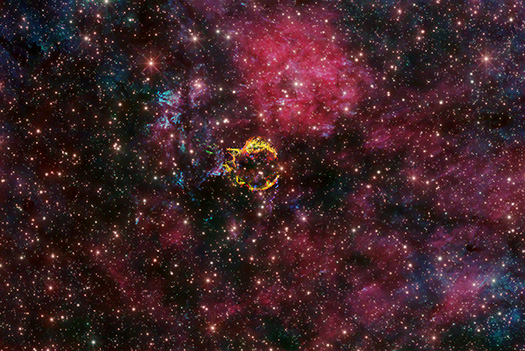
Cassiopeia A
Contributors: Tim Schaeffer, William Ostling, Justin, Adrien Keijzer, Paul Kent, BTB Astroteam Brentenriegel, Steve Gill, Tino Heuberger, Nicolas Puig, Julian Shapiro, Felix Schöfbänker, Mikhail Vasilev, David Wood
In sports, the term “pro-am” refers to a competition between professional and non-professional athletes. In astronomy, there are also “pro-am” events, but these are highly collaborative and never cutthroat.
AstroBin is an image hosting platform and social network for astrophotographers (also often known as “amateur astronomers”, though their skill and expertise should never be questioned!)
NASA Telescope Data Becomes Music You Can Play
Submitted by chandra on Wed, 2023-11-15 10:39Credit: Composition: NASA/CXC/SAO/Sophie Kastner: Data: X-ray: NASA/CXC/SAO; Optical: NASA/STScI; IR: Spitzer NASA/JPL-Caltech; Sonification: NASA/CXC/SAO/K.Arcand, SYSTEM Sounds (M. Russo, A. Santaguida); Video Credit: NASA/CXC/A. Jubett & P. David
For millennia, musicians have looked to the heavens for inspiration. Now a new collaboration is enabling actual data from NASA telescopes to be used as the basis for original music that can be played by humans.
Since 2020, the “sonification” project at NASA’s Chandra X-ray Center has translated the digital data taken by telescopes into notes and sounds. This process allows the listener to experience the data through the sense of hearing instead of seeing it as images, a more common way to present astronomical data.
A new phase of the sonification project takes the data into different territory. Working with composer Sophie Kastner, the team has developed versions of the data that can be played by musicians.
NASA Telescopes Discover Record-Breaking Black Hole
Submitted by chandra on Mon, 2023-11-06 09:08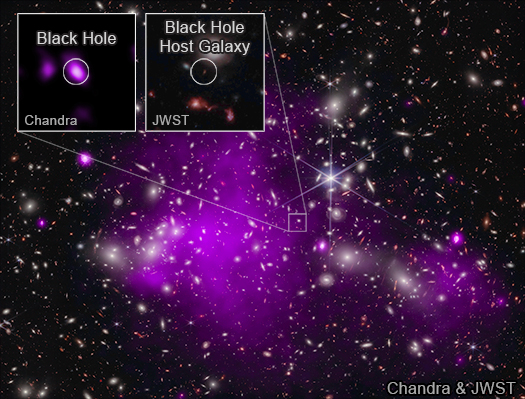
UHZ1
Credit: X-ray: NASA/CXC/SAO/Ákos Bogdán; Infrared: NASA/ESA/CSA/STScI; Image Processing: NASA/CXC/SAO/L. Frattare & K. Arcand
This image contains the most distant black hole ever detected in X-rays, a result that may explain how some of the first supermassive black holes in the universe formed. As we report in our press release, this discovery was made using X-rays from NASA’s Chandra X-ray Observatory (purple) and infrared data from NASA’s James Webb Space Telescope (red, green, blue).
The extremely distant black hole is located in the galaxy UHZ1 in the direction of the galaxy cluster Abell 2744. The galaxy cluster is about 3.5 billion light-years from Earth. Webb data, however, reveal that UHZ1 is much farther away than Abell 2744. At some 13.2 billion light-years away, UHZ1 is seen when the universe was only 3% of its current age.
X-raying the Magnetic Field Bones of the Cosmic Hand
Submitted by chandra on Fri, 2023-10-27 10:36
Roger Romani
We welcome Roger W. Romani as a guest blogger. Roger is the first author of a paper that is the subject of our latest Chandra release. He has been a professor of Physics at Stanford University for 30-odd years and helped found KIPAC, its institute focusing on astrophysics and cosmology. He is interested in high energy astrophysics problems of all sorts and likes to bring observations from multiple wavebands together with modeling to explain astrophysical puzzles. However, he has a special fondness for the extreme physics conditions associated with pulsars and their environments. Today’s blog gives one such example.
Magnetic fields are the binding agent that turn interstellar atoms into gases. Between the stars the particle density is so low that, without these fields, individual atoms would fly along like buckshot, essentially never colliding. But since the atoms are often ionized – with a positive charge because negatively charged electrons have been stripped away – their interaction with embedded magnetic fields forces them to flow in concord, resulting in the fluid-like behavior that forms many of the nebulas that enthrall us in astronomical images.
It is surprisingly hard to image this magnetic scaffolding. A new capability for magnetic mapping was introduced with the launch of NASA’s Imaging X-ray Polarimetry Explorer (IXPE) in late 2021. This telescope is sensitive to 1-10 keV X-rays and, using an ingenious photo-electron tracking camera developed by our Italian colleagues, is able to sense the polarization, or orientation of the electric field in the electromagnetic wave, of the individual X-ray events. (An “eV” is an electron volt, a unit that represents how much energy an electron gains when it is accelerated by the potential of one volt. A “keV” is 1000 eV.) So together with its imaging, timing, and energy resolution capabilities, IXPE can, for the first time, extract (albeit imperfectly) all of the information carried by each X-ray photon. The result is a color movie of the target, which also shows how the local emission is polarized.
IXPE and Chandra Untangle Theories Surrounding Historic Supernova Remnant
Submitted by chandra on Tue, 2023-10-24 10:56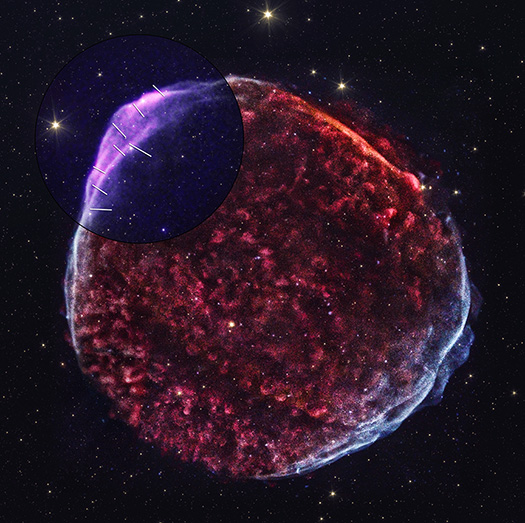
SN 1006 in X-ray and Optical Light
Credit: X-ray: NASA/CXC/SAO (Chandra); NASA/MSFC/Nanjing Univ./P. Zhou et al. (IXPE); IR: NASA/JPL/CalTech/Spitzer; Image Processing: NASA/CXC/SAO/J.Schmidt
When the object now called SN 1006 first appeared on May 1, 1006 A.D., it was far brighter than Venus and visible during the daytime for weeks. Astronomers in China, Japan, Europe, and the Arab world all documented this spectacular sight, which was later understood to have been a supernova. With the advent of the Space Age in the 1960s, scientists were able to launch instruments and detectors above Earth's atmosphere to observe the Universe in wavelengths that are blocked from the ground, including X-rays. The remains of SN 1006 was one of the faintest X-ray sources detected by the first generation of X-ray satellites.
This new image shows SN 1006 from two of NASA’s current X-ray telescopes, the Chandra X-ray Observatory and Imaging X-ray Polarimetry Explorer (IXPE). In the full image of SN 1006, red, green, and blue show low-, medium-, and high-energy detected by Chandra. The IXPE data, which measure the polarization of the X-ray light, have been added in the upper left corner of the remnant in purple. The lines in that corner represent the direction of the magnetic field.
NASA's Chandra Rewinds Story of Great Eruption of the 1840s
Submitted by chandra on Mon, 2023-09-25 13:38Credit: X-ray: NASA/SAO/GSFC/M. Corcoran et al.;
Image Processing: L. Frattare, J. Major, N. Wolk (SAO/CXC)
A new movie made from over two decades of data from NASA’s Chandra X-ray Observatory shows a famous star system changing with time, as described in our latest press release. Eta Carinae contains two massive stars (one is about 90 times the mass of the Sun and the other is believed to be about 30 times the Sun’s mass).
In the middle of the 19th century, skywatchers observed as Eta Carinae experienced a huge explosion that was dubbed the “Great Eruption.” During this event, Eta Carinae ejected between 10 and 45 times the mass of the Sun. This material became a dense pair of spherical clouds of gas, now called the Homunculus nebula, on opposite sides of the two stars. The Homunculus is clearly seen in a composite image of the Chandra data with optical light from the Hubble Space Telescope (blue, purple, and white).
A new time-lapse sequence contains frames of Eta Carinae taken with Chandra from 1999, 2003, 2009, 2014, and 2020. Astronomers used the Chandra observations along with data from ESA’s XMM-Newton to watch as the stellar eruption from about 180 years ago continues to expand into space at speeds up to 4.5 million miles per hour. The two massive stars produce the blue, relatively high energy X-ray source in the center of the ring. They are too close to each other to be seen individually.
A Fab Five: New Images With NASA's Chandra X-ray Observatory
Submitted by chandra on Tue, 2023-09-12 16:32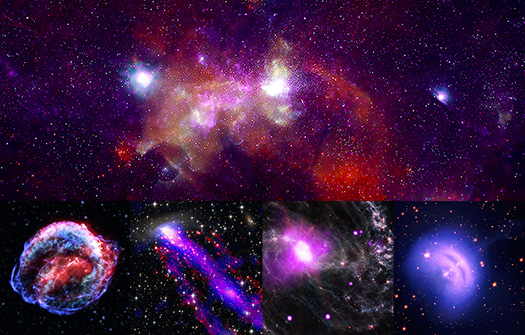
A new collection of stunning images highlights data from NASA’s Chandra X-ray Observatory and other telescopes.
Credit: NASA/CXC/SAO, JPL-Caltech, MSFC, STScI, ESA/CSA, SDSS, ESO
A new collection of stunning images highlights data from NASA’s Chandra X-ray Observatory and other telescopes. These objects have been observed in light invisible to human eyes — including X-rays, infrared, and radio — by some of the world’s most powerful telescopes. The data from different types of light has been assigned colors that the human eye can perceive, allowing us to explore these cosmic entities.
The objects in this quintet of images range both in distance and category. Vela and Kepler are the remains of exploded stars within our own Milky Way galaxy, the center of which can be seen in the top panorama. In NGC 1365, we see a double-barred spiral galaxy located about 60 million light-years from Earth. Farther away and on an even larger scale, ESO 137-001 shows what happens when a galaxy hurtles through space and leaves a wake behind it.
Welcoming a New Member of the X-ray Family
Submitted by chandra on Fri, 2023-08-25 10:27
Artist's concept of the XRISM (X-ray Imaging and Spectroscopy Mission) spacecraft.
Credit: NASA's Goddard Space Flight Center Conceptual Image Lab
On September 6th, a new X-ray telescope was launched into space, joining the Chandra X-ray Observatory, XMM-Newton, and others already exploring the high-energy Universe.
The X-ray Imaging and Spectroscopy Mission (XRISM, pronounced “crism”) is led by the Japanese Aerospace Exploration Agency, or JAXA, with contributions from NASA and the European Space Agency.
What will scientists use XRISM for? This feature from NASA describes some of what is can do and the embedded video does an excellent job explaining why ‘spectroscopy’ is so important to astronomers and their study of the Universe.
https://www.nasa.gov/feature/feature/2023/xrism-spacecraft-will-open-new...
Chandra Studies a Moderately Massive Star Destroyed by a Giant Black Hole In Another Galaxy
Submitted by chandra on Wed, 2023-08-16 11:00We are happy to welcome Dr. Brenna Mockler as our guest blogger. Brenna is a postdoctoral fellow at Carnegie Observatories in Pasadena. Her research is primarily on high-energy transients, with a focus on learning about the supermassive black holes in the centers of galaxies and the environments they live in. Prior to her current position, she was a UC Chancellor's fellow at UCLA. She earned her PhD in Astronomy & Astrophysics from the University of California at Santa Cruz in 2022, and a bachelor's degree in Physics from Cornell University in 2016.
At the center of most large galaxies lies a supermassive black hole, larger than our solar system and millions to billions of times more massive than our Sun. These giant black holes influence the evolution of the entire galaxy — for example, they are thought to regulate star formation and their mass is strongly correlated with the mass of the galaxy. Supermassive black holes live in ‘galactic nuclei’ — dense, extreme environments, packed with thousands to millions of times the density of stars that we see in our own night sky.
While we can estimate the bulk characteristics of these nuclei, it is challenging to measure the individual components that make them up. Because there are so many stars packed so closely together, it is very difficult to pick out the unique characteristics of each star. Imagine you are out in the suburbs staring at a distant city skyline — you can tell there is a lot of light, but you can’t pick out the details of each individual lamppost and billboard. However, occasionally one of these stars will pass too close to the supermassive black hole at the center, and get ripped apart by the tidal forces from the black hole in a “tidal disruption event” (TDE).
"El Gordo": A Galaxy Cluster That Pushes the Limits
Submitted by chandra on Wed, 2023-08-02 10:01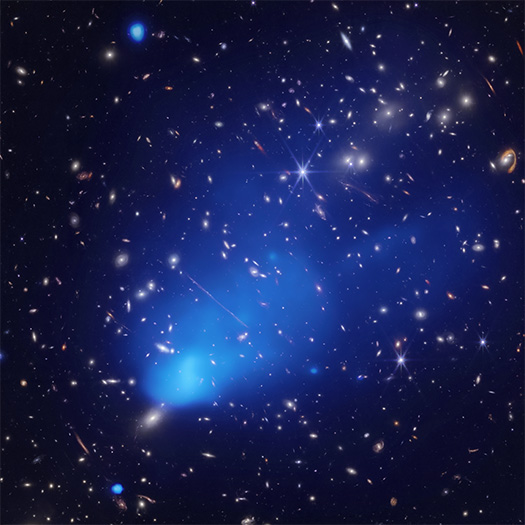
El Gordo
Credit: X-ray: NASA/CXC/Rutgers/J. Hughes et al.; Infrared: NASA/ESA/CSA, J.M. Diego (IFCA), B.Frye (Univ. of Arizona), P.Kamieneski, T.Carleton & R.Windhorst (ASU);
When astronomers discovered the galaxy cluster ACT-CL J0102-4915 in 2012 with NASA's Chandra X-ray Observatory and ground-based optical telescopes, they nicknamed it "El Gordo" (Spanish for the "Fat One") because of its gigantic mass. Scientists estimate that El Gordo contains as much as 3 million billion (3,000,000,000,000,000) times the mass of the Sun. Thanks to its heft, El Gordo acts as a natural lens, distorting the light from more distant objects behind it through a process known as gravitational lensing.
A new composite image of El Gordo shows the diffuse, superheated gas in the cluster observed in X-rays from Chandra (blue) that have been combined with a new infrared image from NASA's James Webb Space Telescope (red, green, and blue). Webb's image shows galaxies in El Gordo plus background galaxies located further away from Earth. El Gordo is located about 7.3 billion light-years from Earth and the background galaxies are at a range of different distances including several that are 12.3 billion light-years from Earth. The appearance of some of the background galaxies has been distorted into a variety of unusual and highly elongated shapes because of gravitational lensing by the cluster.
Pages
Please note this is a moderated blog. No pornography, spam, profanity or discriminatory remarks are allowed. No personal attacks are allowed. Users should stay on topic to keep it relevant for the readers.
Read the privacy statement




